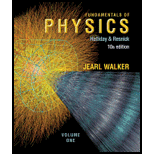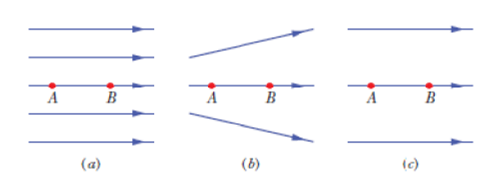
Concept explainers
Figure 22-22 shows three arrangements of electric held lines. In each arrangement, a proton is released from rest at point A and is then accelerated through point B by the electric field. Points A and B have equal separations in the three arrangements. Rank the arrangements according to the linear momentum of the proton at point B, greatest first.

Figure 22-22 Qustion 1.
To rank:
The given situations according to the linear momentum of a proton released from rest in an electric field at point A.
Answer to Problem 1Q
Solution:
(a)> (b)> (c).
Explanation of Solution
1) Concept:
Electric field strength is directly proportional to the density of field lines. Hence, the field is stronger when the lines are closely located and weaker when the lines are farther away. According to Newton’s second law, the rate of change of linear momentum of a body depends on the force acting on the body. Hence, the stronger the electric field, greater the force will be and also greater the linear momentum will be.
2) Formulae:
Electric field strength,
3) Given:
A proton is released from rest at point A and is then accelerated through point B.
4) Calculations:
Let us look at the given situations.

In case a, the field lines are closely located than in case b and c. Therefore the linear momentum of proton at B is greatest in case a.
In case b, the field lines are diverging from A towards B. In C the distance between field lines are farther than in case b and c. Therefore the electric field is greater in case b than in case c. Thus momentum of proton is greater in case b than case c.
Conclusion:
Using the relationship between linear momentum and force of a particle we can compare the momentum in the given scenarios.
Want to see more full solutions like this?
Chapter 22 Solutions
Fundamentals of Physics, Volume 1, Chapter 1-20
Additional Science Textbook Solutions
Essential University Physics: Volume 1 (3rd Edition)
University Physics Volume 2
Tutorials in Introductory Physics
Physics (5th Edition)
College Physics
Physics for Scientists and Engineers: A Strategic Approach with Modern Physics (4th Edition)
- placed in a uniform electric field E of magnitude 20 N/C. Figure 22-62 gives a the potential energy U of the dipole versus the angle e between E and the dipole moment p. The vertical axis scale is set by U, - 100 x 10-28 J. What U, is the magnitude of p? -U, Finure 22-62 Problem 58 (f s-01)Aarrow_forwardDetermine the magnitude of the electric field at the surface of a lead-207 nucleus, which contains 82 protons and 125 neutrons. Assume the lead nucleus has a volume 207 times that of one proton and consider a proton to be a sphere of radius 1.20 ✕ 10-15 m.arrow_forwardTwo horizontal plates of opposite charge form a constant electric field = 1000 N/C directed vertically downwards. An electron of mass me and charge e* is fired horizontally with velocity v = 0.1c, where c = 3.00 x 108 m/s between the plates. Calculate the electron's acceleration. If the plates have length 1 m, find the electron's deflection from the horizontal when it emerges.arrow_forward
- 84 In Fig. 22-68, a uniform, upward electric field E of magnitude 2.00 x 10° N/C has been set up between two horizontal plates by charging the lower plate positively and the upper plate negatively. The plates have Figure 22-68 Problem 84. length L = 10.0 cm and separation d = 2.00 cm. An electron is then shot between the plates from the left edge of the lower plate. The initial velocity vo of the electron makes an angle e = 45.0° with the lower plate and has a magnitude of 6.00 x 10° m/s. (a) Will the electron strike one of the plates? (b) If so, which plate and how far horizon- tally from the left edge will the electron strike? 7. 1:0arrow_forwardA particle of mass m and charge q is placed at rest in a uniform electric field E and then released. The kinetic energy attained by the particle after moving a distance y is : A) qEy²| [AIPMT 1998] B) qE* C) qEy D) q² Eyarrow_forwardPROBLEM. A point charge(+) of 2 nCoulomb is situated in the air at the origin ( x=0, y=0), and a point charge(-) of -3nCoulomb is situated on the y-axis 1 meter from the origin (x=0, y=1). Calculate for the total electric field intensity at the point P on the x axis 2 meter from the origin (x=2, y=0).arrow_forward
- Planes z = 0 and z = 2, respectively carry charges -10nC/m2 and +10nC/m2. Calculate the Electric Field Intensity at the points (0,0,1), (0,0,3) and (0,0,-1).arrow_forwardA uniform electric field of magnitude 640 N/C exists between two parallel plates that are 4.00 cm apart. A proton is released from rest at the positive plate at the same instant an electron is released from rest at the negative plate. (a) Determine the distance from the positive plate at which the two pass each other. Ignore the electrical attraction between the proton and elec- tron. (b) What If? Repeat part (a) for a sodium ion (Na*) and a chloride ion (CI¯).arrow_forwardproton is released from rest (v_i=0) in a uniform electric field E ⃗, as shown in the figure 3. After it runs a distance x=1.67 m, its speed becames v=6.5×10^5 m⁄s. Calculate the magnitude of the uniform electric field (in N/C)?arrow_forward
- A small, permanent dipole near the origin has dipole moment that points in the + direction. Suppose the electric field at the point (x, y) = (0, r) is Eo(+3) (where r is much greater than the distance separating the charges of the dipole). What is a very good approximation for the electric field at the point (x, y) = (r, 0)? Eo(+3) Eo(-3) (1/2) Eo(-3) (1/2) Eo(+3) 2Eo(+3) 2Eo (-3) I DON'T KNOW YETarrow_forwarda)A particle of charge qA = +6nC at point A is located at rA = <2,-5,0>cm. What is the electric field EA due to this particle at the origin <0,0,0>cm? b) A second particle of charge qB = -6nC is placed at location B. The total electric field at the origin is now E = <-1E-4,0,0> N/C. Determine the location of point B(i.e. find rB) Hint: Drawing a diagram and treating the charges at points A and B as a dipole may help simplify this problem.arrow_forwardA point particle with mass m = 3.6 g and charge q = -4 µC is placed into a uniform + + + + + + + + + + + + + + electric field |E| = 3 x 10° N/C produced by the two oppositely charged plates shown in the figure (the distance between the plates is d = 16 cm). If the particle is released from the lower plate at rest, at what speed does it reach the upper plate in units of m/s? (Take g = 10 m/s².)arrow_forward
 College PhysicsPhysicsISBN:9781305952300Author:Raymond A. Serway, Chris VuillePublisher:Cengage Learning
College PhysicsPhysicsISBN:9781305952300Author:Raymond A. Serway, Chris VuillePublisher:Cengage Learning University Physics (14th Edition)PhysicsISBN:9780133969290Author:Hugh D. Young, Roger A. FreedmanPublisher:PEARSON
University Physics (14th Edition)PhysicsISBN:9780133969290Author:Hugh D. Young, Roger A. FreedmanPublisher:PEARSON Introduction To Quantum MechanicsPhysicsISBN:9781107189638Author:Griffiths, David J., Schroeter, Darrell F.Publisher:Cambridge University Press
Introduction To Quantum MechanicsPhysicsISBN:9781107189638Author:Griffiths, David J., Schroeter, Darrell F.Publisher:Cambridge University Press Physics for Scientists and EngineersPhysicsISBN:9781337553278Author:Raymond A. Serway, John W. JewettPublisher:Cengage Learning
Physics for Scientists and EngineersPhysicsISBN:9781337553278Author:Raymond A. Serway, John W. JewettPublisher:Cengage Learning Lecture- Tutorials for Introductory AstronomyPhysicsISBN:9780321820464Author:Edward E. Prather, Tim P. Slater, Jeff P. Adams, Gina BrissendenPublisher:Addison-Wesley
Lecture- Tutorials for Introductory AstronomyPhysicsISBN:9780321820464Author:Edward E. Prather, Tim P. Slater, Jeff P. Adams, Gina BrissendenPublisher:Addison-Wesley College Physics: A Strategic Approach (4th Editio...PhysicsISBN:9780134609034Author:Randall D. Knight (Professor Emeritus), Brian Jones, Stuart FieldPublisher:PEARSON
College Physics: A Strategic Approach (4th Editio...PhysicsISBN:9780134609034Author:Randall D. Knight (Professor Emeritus), Brian Jones, Stuart FieldPublisher:PEARSON





